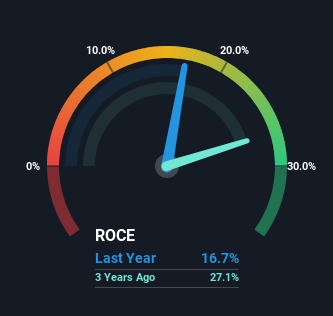- India
- /
- Healthcare Services
- /
- NSEI:KIMS
We Like These Underlying Return On Capital Trends At Krishna Institute of Medical Sciences (NSE:KIMS)
If you're not sure where to start when looking for the next multi-bagger, there are a few key trends you should keep an eye out for. Amongst other things, we'll want to see two things; firstly, a growing return on capital employed (ROCE) and secondly, an expansion in the company's amount of capital employed. If you see this, it typically means it's a company with a great business model and plenty of profitable reinvestment opportunities. So when we looked at Krishna Institute of Medical Sciences (NSE:KIMS) and its trend of ROCE, we really liked what we saw.
What Is Return On Capital Employed (ROCE)?
Just to clarify if you're unsure, ROCE is a metric for evaluating how much pre-tax income (in percentage terms) a company earns on the capital invested in its business. To calculate this metric for Krishna Institute of Medical Sciences, this is the formula:
Return on Capital Employed = Earnings Before Interest and Tax (EBIT) ÷ (Total Assets - Current Liabilities)
0.17 = ₹5.1b ÷ (₹34b - ₹3.6b) (Based on the trailing twelve months to December 2023).
Therefore, Krishna Institute of Medical Sciences has an ROCE of 17%. In absolute terms, that's a satisfactory return, but compared to the Healthcare industry average of 14% it's much better.
See our latest analysis for Krishna Institute of Medical Sciences

Above you can see how the current ROCE for Krishna Institute of Medical Sciences compares to its prior returns on capital, but there's only so much you can tell from the past. If you'd like, you can check out the forecasts from the analysts covering Krishna Institute of Medical Sciences for free.
What Does the ROCE Trend For Krishna Institute of Medical Sciences Tell Us?
The trends we've noticed at Krishna Institute of Medical Sciences are quite reassuring. The data shows that returns on capital have increased substantially over the last five years to 17%. The amount of capital employed has increased too, by 443%. This can indicate that there's plenty of opportunities to invest capital internally and at ever higher rates, a combination that's common among multi-baggers.
One more thing to note, Krishna Institute of Medical Sciences has decreased current liabilities to 11% of total assets over this period, which effectively reduces the amount of funding from suppliers or short-term creditors. So shareholders would be pleased that the growth in returns has mostly come from underlying business performance.
In Conclusion...
In summary, it's great to see that Krishna Institute of Medical Sciences can compound returns by consistently reinvesting capital at increasing rates of return, because these are some of the key ingredients of those highly sought after multi-baggers. And with a respectable 37% awarded to those who held the stock over the last year, you could argue that these developments are starting to get the attention they deserve. In light of that, we think it's worth looking further into this stock because if Krishna Institute of Medical Sciences can keep these trends up, it could have a bright future ahead.
On a separate note, we've found 1 warning sign for Krishna Institute of Medical Sciences you'll probably want to know about.
While Krishna Institute of Medical Sciences isn't earning the highest return, check out this free list of companies that are earning high returns on equity with solid balance sheets.
Valuation is complex, but we're here to simplify it.
Discover if Krishna Institute of Medical Sciences might be undervalued or overvalued with our detailed analysis, featuring fair value estimates, potential risks, dividends, insider trades, and its financial condition.
Access Free AnalysisHave feedback on this article? Concerned about the content? Get in touch with us directly. Alternatively, email editorial-team (at) simplywallst.com.
This article by Simply Wall St is general in nature. We provide commentary based on historical data and analyst forecasts only using an unbiased methodology and our articles are not intended to be financial advice. It does not constitute a recommendation to buy or sell any stock, and does not take account of your objectives, or your financial situation. We aim to bring you long-term focused analysis driven by fundamental data. Note that our analysis may not factor in the latest price-sensitive company announcements or qualitative material. Simply Wall St has no position in any stocks mentioned.
About NSEI:KIMS
Krishna Institute of Medical Sciences
Provides medical and health care services under the KIMS Hospitals brand in India.
Exceptional growth potential with imperfect balance sheet.
Market Insights
Community Narratives


Recently Updated Narratives


Engineered for Stability. Positioned for Growth.


MINISO's fair value is projected at 26.69 with an anticipated PE ratio shift of 20x


Fiverr International will transform the freelance industry with AI-powered growth
Popular Narratives


MicroVision will explode future revenue by 380.37% with a vision towards success


NVDA: Expanding AI Demand Will Drive Major Data Center Investments Through 2026



